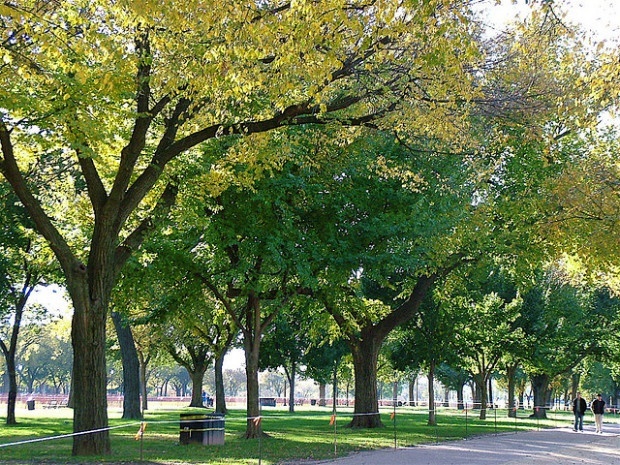We have much more to do and your continued support is needed now more than ever.
Have You Hugged a Tree Lately?
Guest post by Melinda Housholder.
When I did field work with the National Park Service a few years ago along the National Mall, I hugged trees on a daily basis. Well, by that I mean, when checking for the DBH (diameter at breast height) of specific trees, I often had my arms wrapped around trees. Not in a uniform, I am sure it looked like I was just a visitor to D.C., taking some time out of my day to embrace the tree for a moment of gratitude. And, well, why shouldn’t I?

As director of the Urban Forests Program at American Forests, I have had the opportunity to learn about what cities across the U.S. are doing to make their urban environments better places to live. With more than 80 percent of the U.S. population living in urban areas, and that number exponentially increasing, cities across the country are seeking ways to promote community well-being, connect to nature and live in healthy vibrant communities. One key way to do this is through urban forests.
While the term might seem like an oxymoron at first glance, it is not. American Forests defines urban forests as “ecosystems of trees and other vegetation in and around communities that may consist of street and yard trees, vegetation within parks and along public rights of way and water systems. Urban forests provide communities with environmental, economic and social benefits and habitat for fish and wildlife.” Thus, urban forests are not only about the trees in the city, but rather, they are a critical part of the green infrastructure that makes up the city ecosystem.

Yet, one of the challenges that we face living in urban environments is the tendency to think nature only exists “out there” — somewhere in the mountains, in the large parks or reserves, somewhere far away from our own backyard. But this just isn’t the case. If you look out your window, I bet you can see at least one tree or some greenspace. And this greenspace not only improves our own human health and well-being, but it is increasingly critical for maintaining the biodiversity of our planet.
Urban forests provide critical habitat to wildlife in cities, especially those reliant on migration corridors for their species’ survival. A 2010 study showed that even small patches of urban forests are key for migrating birds, such as Swainson’s thrush, a species that is declining throughout much of its range. In urban areas in Minnesota, approximately 35 bird species nest in or are permanent residents of urban forests, three of which are species of state conservation concern: the northern flicker, chimney swift and brown thrasher.
As, Douglas Tallamy, chair of the Department of Entomology and Wildlife Ecology at the University of Delaware, notes:
“Every time we bulldoze a native plant community, we are reducing the amount of food available for our fellow creatures … We can no longer landscape with aesthetics as our only goal. We must also consider the function of our landscapes if we hope to avoid a mass extinction that we ourselves are not likely to survive.”
Proposing to use native plants as a key to avoiding this mass extinction, he urges “as gardeners and stewards of our land, we have never been so empowered to help save biodiversity from extinction, and the need to do so has never been so great.”
Thus, whether it is a tree in a backyard, along a city street, on a rooftop or in a tiny plot on a city corner, take a moment to think about value of the trees. Embrace them for all they provide.
Shall I even say … hug them.
 Melinda Housholder is the Director of the Urban Forests Program at American Forests, the oldest national nonprofit conservation organization in the country. Melinda directs American Forests’ initiatives to advance the understanding and use of science-based measures of urban forests’ ecosystem services and to raise awareness of the values of sustainable urban forests across the country. She often writes for the American Forests’ Loose Leaf blog on current urban forest issues. Prior to joining American Forests in 2011, she worked at the National Park Service in Washington D.C., as well as with the Africa Biodiversity Collaborative Group and the Jane Goodall Institute. She holds a M.S. in Sustainable Development & Conservation Biology and a M.P.P in Environmental Public Policy from the University of Maryland.
Melinda Housholder is the Director of the Urban Forests Program at American Forests, the oldest national nonprofit conservation organization in the country. Melinda directs American Forests’ initiatives to advance the understanding and use of science-based measures of urban forests’ ecosystem services and to raise awareness of the values of sustainable urban forests across the country. She often writes for the American Forests’ Loose Leaf blog on current urban forest issues. Prior to joining American Forests in 2011, she worked at the National Park Service in Washington D.C., as well as with the Africa Biodiversity Collaborative Group and the Jane Goodall Institute. She holds a M.S. in Sustainable Development & Conservation Biology and a M.P.P in Environmental Public Policy from the University of Maryland.





















